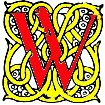Extract of commentary from Evan Macdonald's PowerPoint Presentation on the church, kindly contributed by the author, who is an elder of the church.

hat do we know about Thomson’s original colour scheme of the sanctuary? Regrettably, no description of it exists. In his obituary it was said that Thomson had been denied the opportunity of decorating the church. One observer has recently suggested that Thomson wished to decorate the high blank wall at the rear of the gallery with a fresco, but as the congregation may have considered this out of place for a Presbyterian place of worship, it “withheld the responsibility of the colour scheme from him.”
As the flat scarlet and sky blue are reminiscent of colours found in the hall of Thomson’s Holmwood House, it has been suggested that Thomson may have at least “outlined” the colour scheme. With his brother, George, as Session Clerk of the congregation, it is unlikely that his suggestions would not have been listened to, even although they may have vetoed a flamboyant fresco for the north wall.
What we can be sure about, however, is the provenance of the stencilling on the roof woodwork, clearly the work of Thomson. The high roof timbers boast a subtle form of stencilling “in a palette of muted and thin browns, highlighted with occasional reds and blues taken from the walls below. The ... boarding seems to be washed with a faint bluish-green colour as well” (Urquhart 2.3.4).
The important décor survey funded by a charitable trust and carried out in 2007 by Gordon Urquhart and Alan Ferdinand revealed four different decorative schemes in some areas: three different shades of scarlet paint discovered behind the organ screen suggests that this was the preferred colour choice for the walls for most, if not all, of the building’s history. This study has also revealed evidence of original stencil decoration above the pews on the north wall below the gallery and details of a decorative frieze on the south wall inside the organ case.
The present decoration of scarlet walls, colourful frieze and column capitals, dates from the Mears scheme of 1967-68 when it appears that great efforts were made at that time to match these colours to the 1904 décor.
Related Material
Bibliography
Urquhart, Gordon (Heritage Consultancy) and Alan Ferdinand (Historic Paint Consultant), for Page/Park Architects. "St Vincent Street Church, Glasgow." Report on Survey and Research Programme in relation to Historic Interiors. July 2007.
Created 16 November 2020